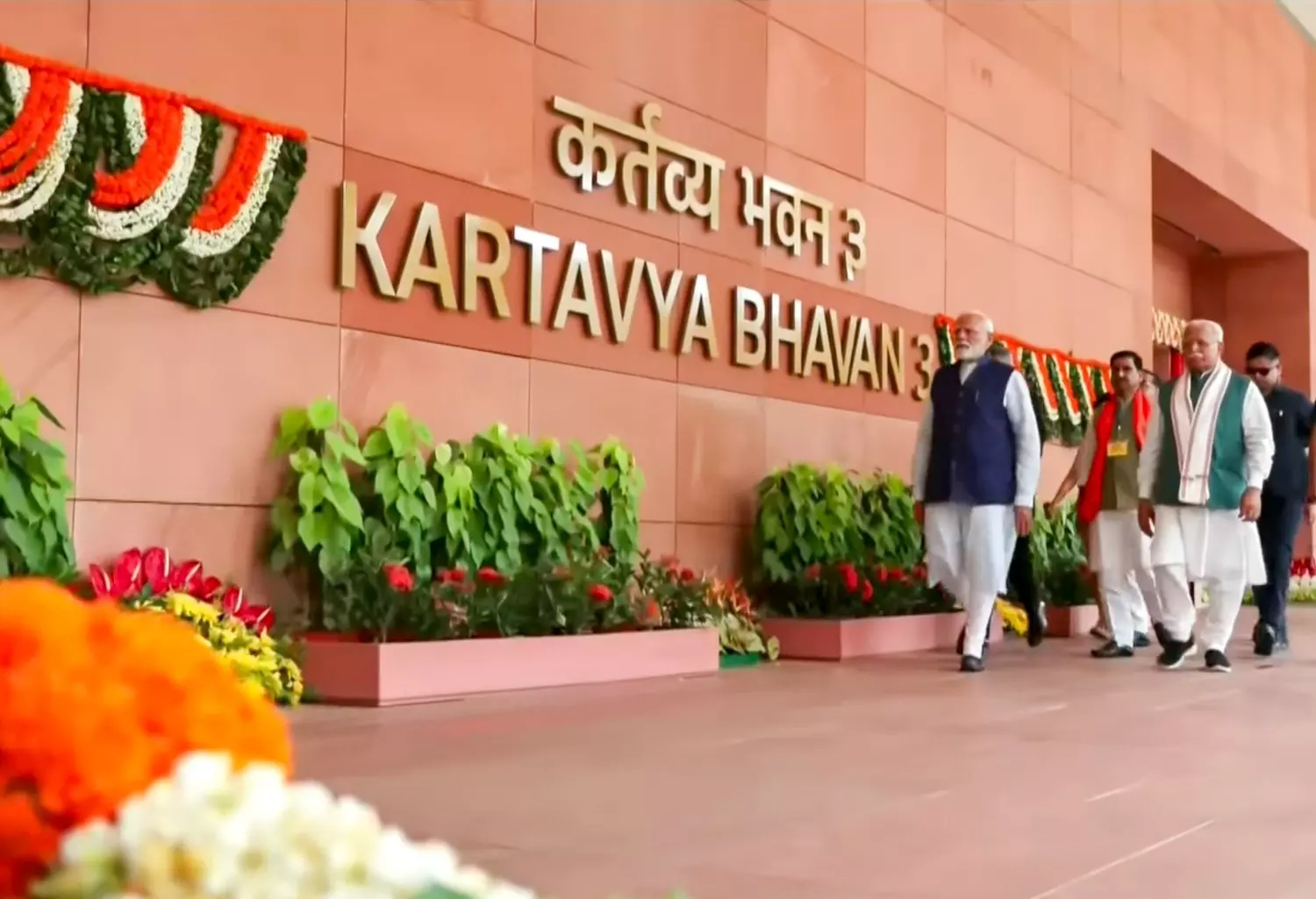
In this screengrab via PMO website, Prime Minister Narendra Modi with Union Minister of Housing and Urban Affairs Manohar Lal during the inauguration of Kartavya Bhavan, in New Delhi, Wednesday, August 6. (PMO via PTI Photo)
Kartavya Bhavan: All you need to know and why officers are not happy
Kartavya Bhavan-3, inaugurated by PM Narendra Modi, will house the Home Affairs, External Affairs, Rural Development, MSME, DoPT, Petroleum & Natural Gas ministries, and the Principal Scientific Adviser's office

Prime Minister Narendra Modi on Wednesday (August 6) inaugurated Kartavya Bhavan, the first of the 10 upcoming Common Central Secretariat (CCS) buildings to house the bureaucracy in New Delhi.
The ambitious project is aimed at bringing ministries and departments under one roof for efficiency.
Also read: Doval in Moscow even as Trump threatens to raise India tariffs ‘very substantially’
All 10 buildings of the CCS will be constructed in the next 22 months, with several ministries housed in Shastri Bhavan, Krishi Bhavan, Nirman Bhavan, and Udyog Bhavan, starting the process to shift to four new locations.
Kartavya Bhavan-3
Kartavya Bhavan-3, the first to be inaugurated, will house the Home Affairs, External Affairs, Rural Development, MSME, DoPT, Petroleum & Natural Gas ministries, and the Principal Scientific Adviser's office.
Also read: Lula to call PM Modi, Xi Jinping for trade talks, snubs Trump
Many key ministries currently function from ageing buildings like Shastri Bhawan, Krishi Bhawan, Udyog Bhawan, and Nirman Bhawan, constructed between the 1950s and 1970s, which are now "structurally outdated and inefficient," according to the government.
The Ministry of Housing and Urban Affairs (HUA) has plans to construct 10 buildings as part of the Common Central Secretariat under the government's Central Vista redevelopment project.
Two under-construction buildings, 2 and 3, are scheduled to be completed by next month, while construction work on CCS 10 will be finished by April next year.
The project of CCS buildings 6 and 7 will be completed by October 2026.
7-floor building spread over 1.5 lakh sqm
Kartavya Bhavan is a modern office complex of about 1.5 lakh square metres spread over two basements and seven floors.
It will lead in sustainability with various power saving and recycling facilities resulting in 30 per cent energy saving and also generating over 5.34 lakh units of electricity annually, as per the Union government.
Kartavya Bhavan has a basement area of 40,000 square metres. Its parking lot can accommodate 600 cars.
The Union Housing and Urban Affairs (HUA) Ministry said that the Kartavya Bhavan-03 has a creche, a yoga room, a medical room, a cafe, a kitchen, and a multipurpose hall.
It has 24 main conference rooms, each with a capacity to seat 45 people, 26 small conference rooms, each with a capacity to seat 25 people, 67 meeting rooms, and 27 lifts.
The HUA ministry said the centralised complexes will reduce red tape, cut down file movement time, and bring about a faster policy implementation.
The new buildings will be equipped with an ID card-based access control system for the secure movement of officials and visitors.
Central Vista redevelopment plan
Under the Central Vista redevelopment plan, the government has already constructed a new Parliament building and the Vice President Enclave, and redeveloped the Kartavya Path that spans from Vijay Chowk to India Gate.
Besides the Common Central Secretariat, the government will also construct an Executive Enclave that will house a new Prime Minister's Office (PMO), Cabinet Secretariat, India House, and National Security Council Secretariat.
Under the second phase of the Executive Enclave, a new Prime Minister's residence will be constructed.
Why officers are unhappy over Kartavya Bhavan
Meanwhile, the Central Secretariat Service (CSS) Forum, representing 13,000 CSS officers, has written to the Prime Minister’s Office (PMO) over the open layout of Kartavya Bhavan-3 and said it poses a serious risk to confidentiality.
“The seating arrangement in Kartavya Bhawan-3 lacks the necessary spatial integrity and functional separation of sections. In addition, multiple sections are housed in a single work hall without clear demarcation. Assistant Section Officers (ASOs), who are central to file processing and examining, lack dedicated storage for both physical files and stationery, as well as partitions between their workspaces,” the letter by the Forum said.
“Under Secretaries, who are entrusted to handle highly sensitive and confidential matters like classified files, court cases, and vigilance issues, require a private workspace. However, they have been provided an open office space, wherein their telephonic and in-person discussions with senior authorities and other officials can easily be overheard, posing a serious risk to confidentiality. This is particularly problematic for sections dealing with sensitive matters, where premature disclosure could compromise outcomes,” the Forum added in the letter addressed to the PM’s Principal Secretary P K Mishra and secretary of the Ministry of Housing and Urban Affairs.

